Will Ubiquiti Update The Ac Pro To Support 802.11 Ax
The best wireless access point is a networking device that needs to go on up with the fast step of tech evolution by implementing the latest technologies suitable for both modest and medium businesses (assuasive the creation of large scalable networks), too as for the habitation user, specially as an equivalent to the mesh WiFi systems. Considering that the demand for such devices is very high, at that place is at present a big variety of wireless admission points to choose from and, based on the wireless functioning, the amount of features, the user-friendliness of the UI, the design and the aforementioned scalability cistron, I chose the best Wi-Fi access points on the market, by taking into account both the 802.11ac and the 802.11ax standards.
UPDATE 09.18.2022: I have added the TP-Link EAP660 Hd to the best wireless access points list
UPDATE: The Xclaim Eleven-3 AP has been removed from the list because the manufacturer decided to announce that the entire series has reached EOL in 2021.
| Zyxel WAX650 WiFi 6 Access Point | TP-Link EAP660 HD Wireless Access Point | EnGenius ECW230 Wireless Admission Point |
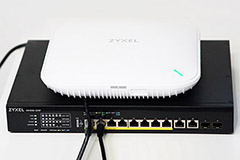 | 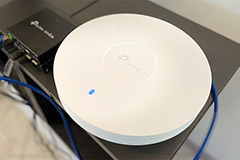 | 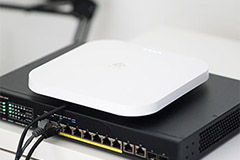 |
| Read More than | Read More | Read More |
 |  |  |
| Ubiquiti UAP-nanoHD Wireless Access Point | EnGenius EAP1250 Wireless Admission Point | Linksys LAPAC1750C Wireless Access Point |
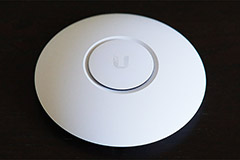 | 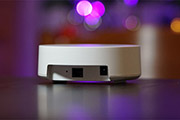 | 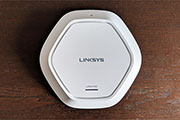 |
| Read More | Read More | Read More than |
 |  |  |
Information technology's true that the wireless access point has the role of converting the data received from a wired Ethernet cablevision into wireless betoken (2.4GHz or 5GHz) but a wireless router can do pretty much the same matter, so i my ask why would you demand a separate access betoken?
Well, routers can definitely practice a great job at serving all the close-by clients, but, there are always WiFi expressionless spots where the signal only won't reach and then, if you have a rather large business firm, you may need at least 1 additional access bespeak to assistance with your network.
While the main purpose of an AP is to extend your network, some manufacturers have taken up to a new level, adopting the mesh networking technology, so yous can use one or two small devices in your home (which are ordinarily very piece of cake to setup) or you lot can use a bunch of them and create a mesh network, where your clients can seamlessly roam the building and have uninterrupted access to the Internet and a steady, strong indicate.
Notation ane: If you have an old router laying around, you may try to convert information technology to an access bespeak and save some money in the process.
Annotation two: I purposely left out the Outdoor Access Points, which volition be the bailiwick of another commodity.
CHECK OUT: THE Best OUTDOOR WIRELESS ACCESS POINTS
All-time wireless access points cursory comparing
| Zyxel WAX650 | TP-Link EAP660 Hd | EnGenius ECW230 | Ubiquiti UAP-nanoHD | EnGenius EAP1250 | Linksys LAPAC1750C | |
| CPU | quad-core 2.0GHz Qualcomm Atheros IPQ8072A | quad-core 2.0GHz Qualcomm Atheros IPQ8072A | quad-core two.0GHz Qualcomm Atheros IPQ8072A | dual-core 880MHz Mediatek MT7621AT | quad-core 717MHz Qualcomm IPQ4018 (ARM Cortex-A7) | single-cadre 700MHz Qualcomm Atheros QCA9558 |
| RAM | 512MB Nanya NT5CC256M16ER-EK | 512MB ESMT (2x M15T4G16256A) | 512MB Micron MT41K256M16TW | 128MB Winbond W632GG6MB-xv | 128MB NANYA NT5CC128M16JR-EK | 128MB (2X) ETRONTECH EM68B16CWQH-25H |
| Storage | 512MB Winbond W29N02GZSIBA) | 128MB ESMT F59D1G81MB-AZM1P0H9N | 256MB MXIC MX30LF2G18AC-XKI | 32MB MXIC MX25L25635FMI-10G | 32MB | 16MB Macronix MXIC MX25L12835FMI-10G |
| Switch | Atheros AR8033-AL1A | Qualcomm QCA8081 | Qualcomm QCA8081 | Mediatek MT7621AT | Qualcomm Atheros QCA8072 | Qualcomm Atheros AR8035-A + Qualcomm Atheros QCA9558 |
| 5GHz Radio | IPQ8072A (QCN5054) 802.11a/n/air conditioning/ax 4×four:iv | IPQ8072A (QCN5054) 802.11a/n/ac/ax 4×4:4 | IPQ8072A (QCN5054) 802.11a/n/ac/ax four×iv:four | Mediatek ARM MT7615N 802.11a/n/air-conditioning 4×4:iv | Qualcomm Atheros IPQ4018 802.11a/northward/ac two×2:2 | Qualcomm Atheros QCA9880 802.11a/north/air-conditioning 3×3 |
| two.4GHz Radio | Qualcomm IPQ8072A (QCN5024) 802.11b/g/due north/ax 4×4:4 | Qualcomm IPQ8072A (QCN5024) 802.11b/1000/northward/ax 4×4:4 | IPQ8072A (QCN5074) 802.11b/chiliad/north/ax 4×four:4 | Mediatek MT7603EN 802.11b/one thousand/northward 2×2:2 | Qualcomm Atheros IPQ4018 802.11b/1000/due north 2×ii:2 | Qualcomm Atheros QCA9558 802.11b/g/n 3×three |
| PoE Back up | 802.3at (48V) | 802.3at (21.5W) | 802.3bt (31W) | 802.3af (44 to 57V) | 802.3af (12V) | 802.3af/at (12V) |
| LAN Ports | 1x 5GbE + 1x 1GbE | 1x ii.5GbE | 1x 2.5GbE | 1x 1GbE | 1x 1GbE | 1x 1GbE |
Which is the fastest wireless bespeak
After I tested all 6 wireless admission points, the Zyxel WAX650S still holds the top place because information technology supports 160MHz aqueduct bandwidth and offers an excellent throughput, but the TP-Link EAP660 Hard disk may take its place at whatsoever time because on the 80MHz, information technology went above the WAX650S and in terms of price, information technology'southward absolutely unbeatable at the moment of writing. It's not surprising that the WiFi 6 access points take the lead considering that they makes use of a few new technologies, as well every bit some improved features from the previous WiFi standard. All devices were tested in the same space and the client device for the WiFi 5 APs was a reckoner equipped with an Asus PCE-AC88 PCIe adapter, while the WiFi half dozen access points were and will be tested using a computer equipped with a TP-Link TX3000E (AX200) adapter. Furthermore, since most WiFi six APs have multi-Gigabit ports, the server device will as well accept a multi-Gigabit port, as to not throttle the functioning of the wireless access point.
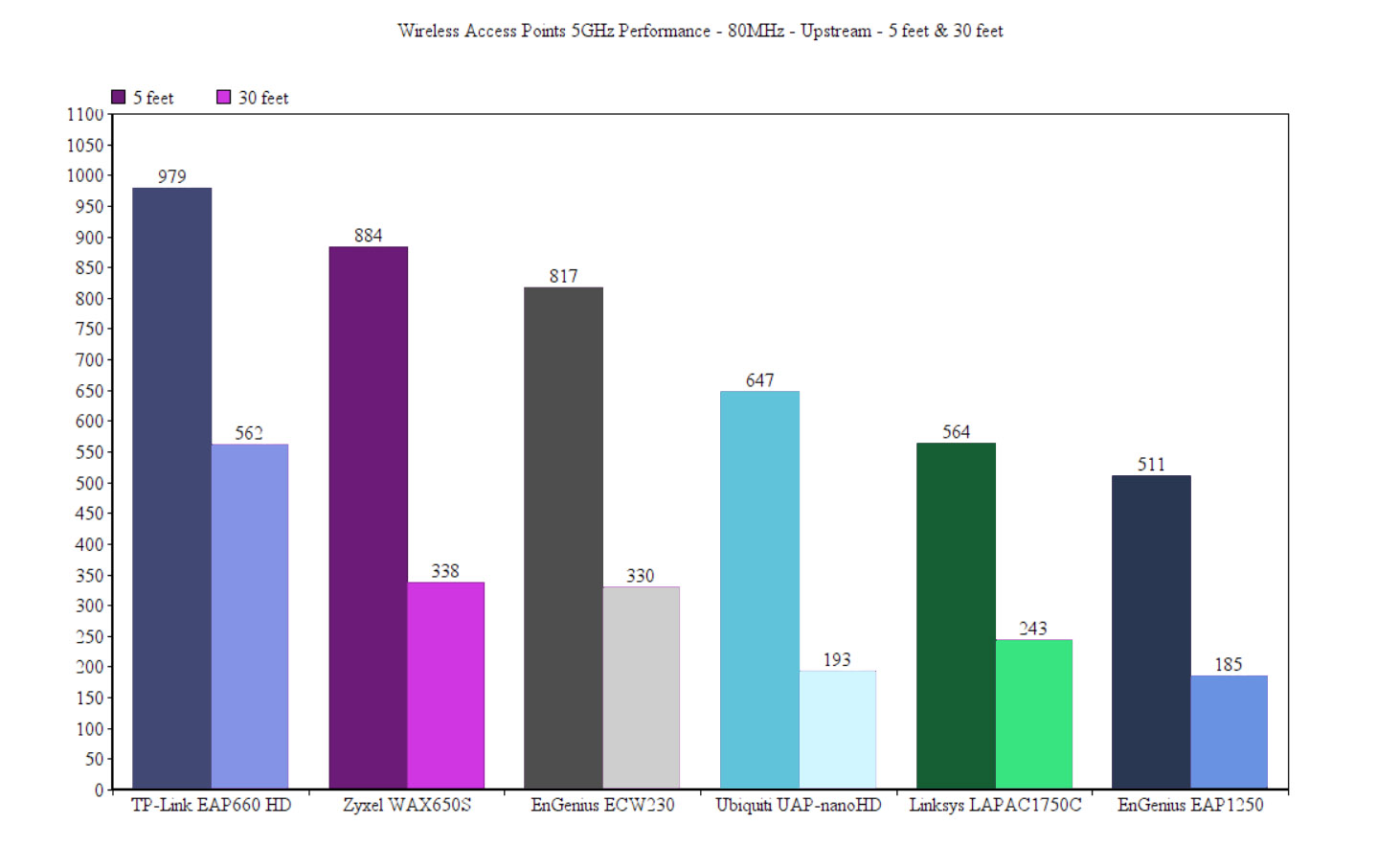
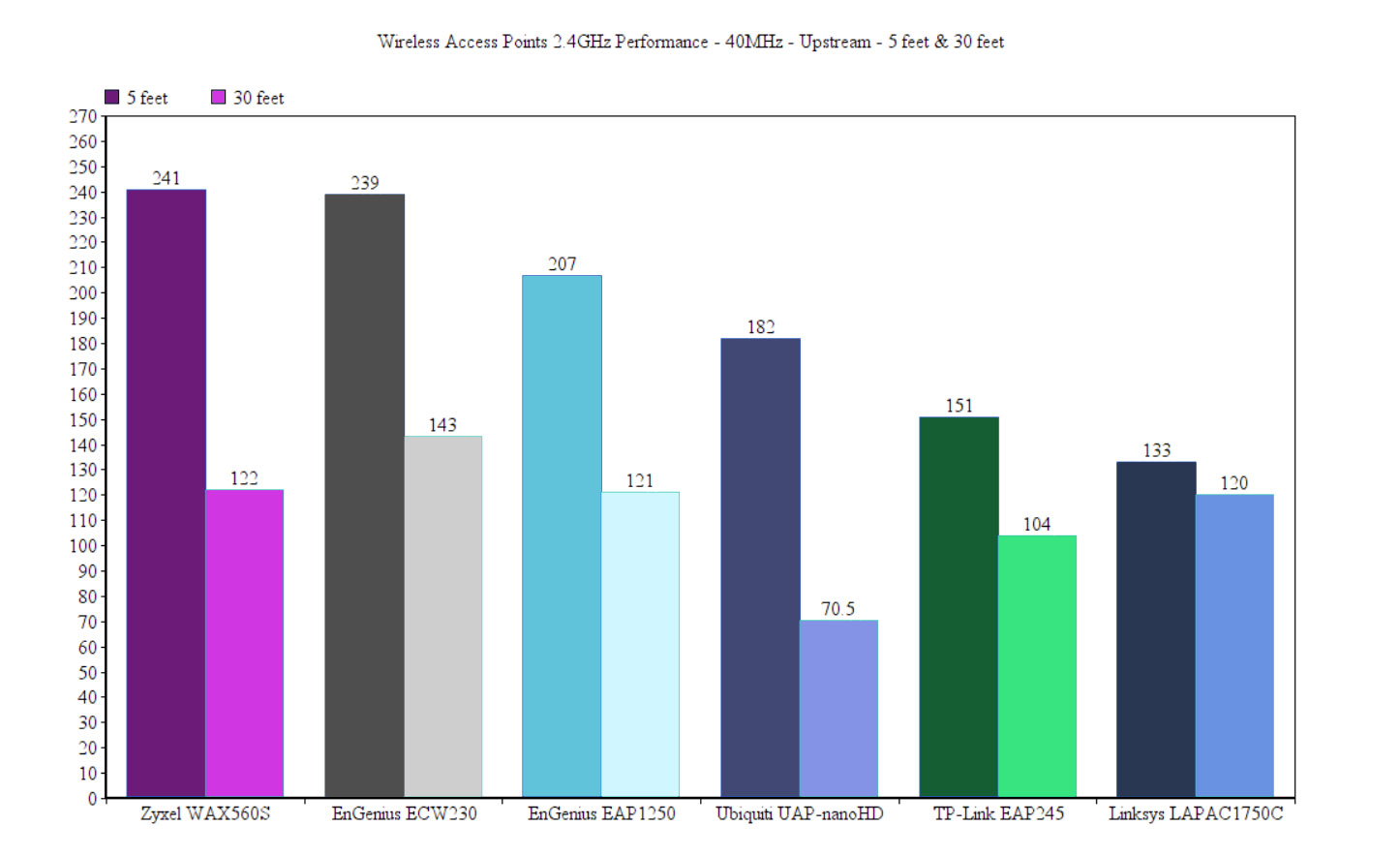
Be aware that being the fastest access point doesn't necessarily mean you have the all-time device for your network, because the software and other features, every bit well equally the price tin counterbalance but as heavy on the value of the access betoken.
ane. Zyxel WAX650S WiFi half dozen Access Point
Read the full review
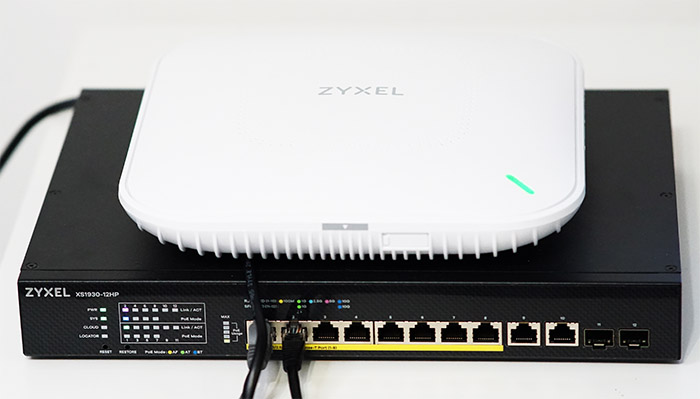
![]()
The Zyxel WAX650S is currently one of the best WiFi half-dozen access points on the market and yes, it'due south not that cheap when compared to other devices from this listing, but this is a device which competes against enterprise-level admission points, so its performance is on a different level. Certain plenty, information technology does make employ of the OFDMA engineering, it has back up for MU-MIMO, Beamforming and 160MHz aqueduct bandwidth, but what I found the most interesting is the support for PoE++. It seems that you will demand a powerful PoE Ethernet switch (such every bit the XS1930-12HP) to be able to apply the most out of this access points and yeah, the WAX650S does come with a 5GbE port to allow y'all to get beyond the erstwhile Gigabit limitation.
Additionally, I do capeesh that the device tin be used in stand-alone mode in a proper way (at that place is a sufficiently comprehensive software), too equally with the NXC controller or, if you lot have a larger network, it will piece of work just fine with the Deject Centre platform.
The Zyxel access points are usually designed on the larger side and the WAX650S is definitely out there as a beefy networking device. Indeed, at 9.25 ten 9.06 x 2.xi inches, this is an admission betoken that you lot're going to see as soon as you enter the room, so mayhap mounting it on the wall would be more aesthetically pleasing than on the ceiling. That being said, I know that some other manufacturers have opted for some aluminum or zinc alloy, but Zyxel decided to keep the upkeep for the inside of the AP, so it made the case entirely from plastic.
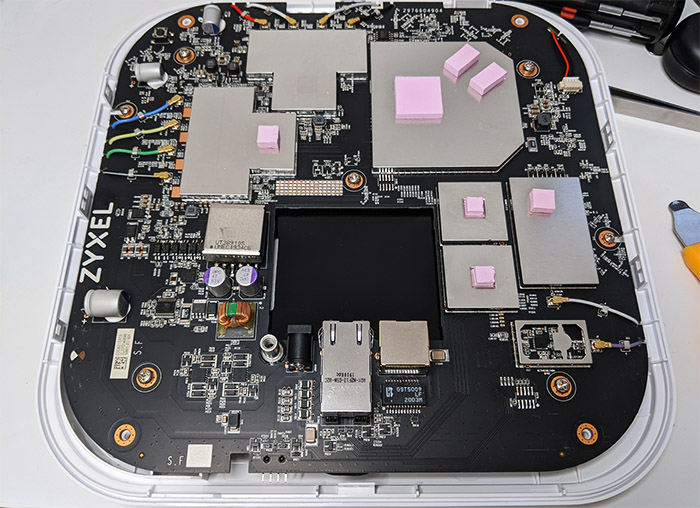
It'southward a hard plastic, then it's fine and the estrus management is too well fabricated considering how crammed up everything is on the inside – there are some fairly hot points, merely it's mostly just warm to the touch on.
If you turn the device upside downwardly, you can clearly see the ii dedicated areas for mounting the device on the ceiling (or on the wall) and in between them, at that place's a carved in area where you can detect the 12V DC-In Ability connector (to power up the AP via a power cable), a 5GbE Uplink port (which can work in 1GbE and two.5GbE style), a LAN1 Gigabit Ethernet port (to connect wired clients) a recessed Reset button (press information technology for about 10 seconds to return the AP to factory default settings) and a grounding screw. I also opened upwards the case of the WAX650S and I could come across that information technology went with the quad-core 2GHz Qualcomm IPQ8072A, 512MB of RAM and 512MB of flash retention, which is excellent.
I have already praised the Zyxel WAX650S for having a keen wireless performance and, when I tested information technology, I used a MacBook Pro + a QNAP QNA-UC5G1T adapter as the server (to get that multi-Gigabit connexion) and a figurer equipped with an AX200 WiFi adapter as the customer. This way, on the 5GHz (160MHz channel bandwidth), I saw an upstream throughput of one,1650Mbps at 5 feet and 351Mbps at 30 anxiety. Using the 80MHz aqueduct bandwidth, the speed went down to an average of 884Mbps at 5 feet and 338Mbps at xxx feet. The 2.4GHz performance (40MHz) was also very good, so I managed to measure an average of 241Mbps at five feet (upstream) and an average of 122Mbps at 30 feet.
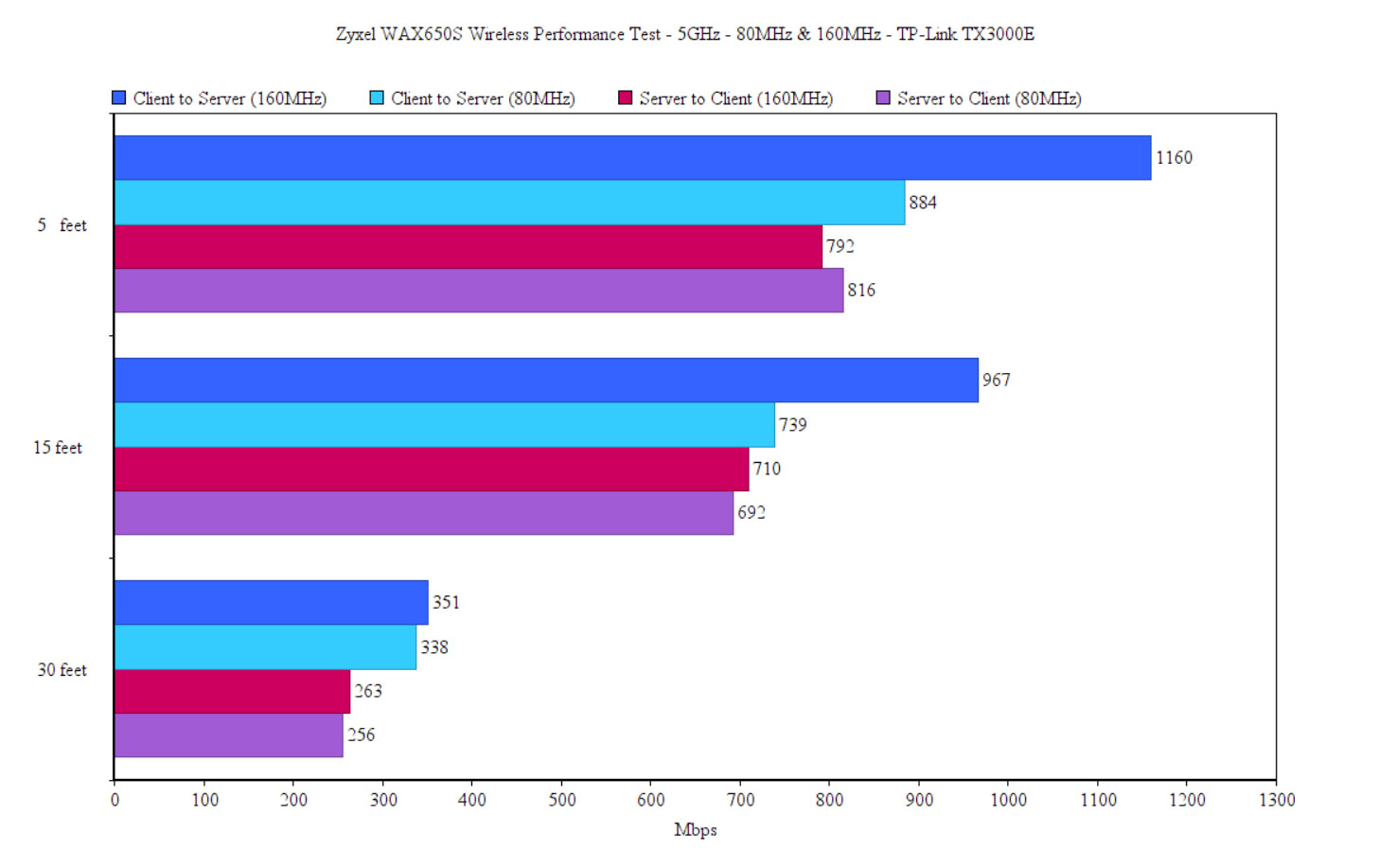
If you lot intend to apply simply a single Zyxel WAX650S unit (or ii), then yous tin use the stand up-lonely user interface (accessible by going to its IP accost – tin can exist found using the ZON utility) and just like the NWA1123-Ac Hard disk, it does offer a satisfying feel, offering more the few basic options that we got with the NAP303. Only the Zyxel WAX650S will also work great with the NCC and y'all can connect to it by using either the Nebula app (Android or iOS) which does make the process very painless or using the Nebula Control Centre which will require a few more steps.
The Dashboard will display blocks of info for every blazon of device connected including the AP area (which shows the number of Online APs, the Total number of APs and the Heavy Loading) or the AP Client area, but, to monitor and configure the access indicate, you demand to go to the AP expanse (from the top menu) and, if yous click on it, information technology will summon a pocket-size driblet-downward menu with options grouped into two categories: Monitor and Configure. Under Monitor, y'all tin view all the adopted APs and past clicking on whatever of them, information technology will have yous to a dedicated page which includes more than in-depth details about the device (as well as some Alive tools to help y'all diagnose whatever connection issue); at that place'due south also the Client listing (click on any to view more than details well-nigh that specific client), the Event log, the Summary report (full general AP stats) and more.
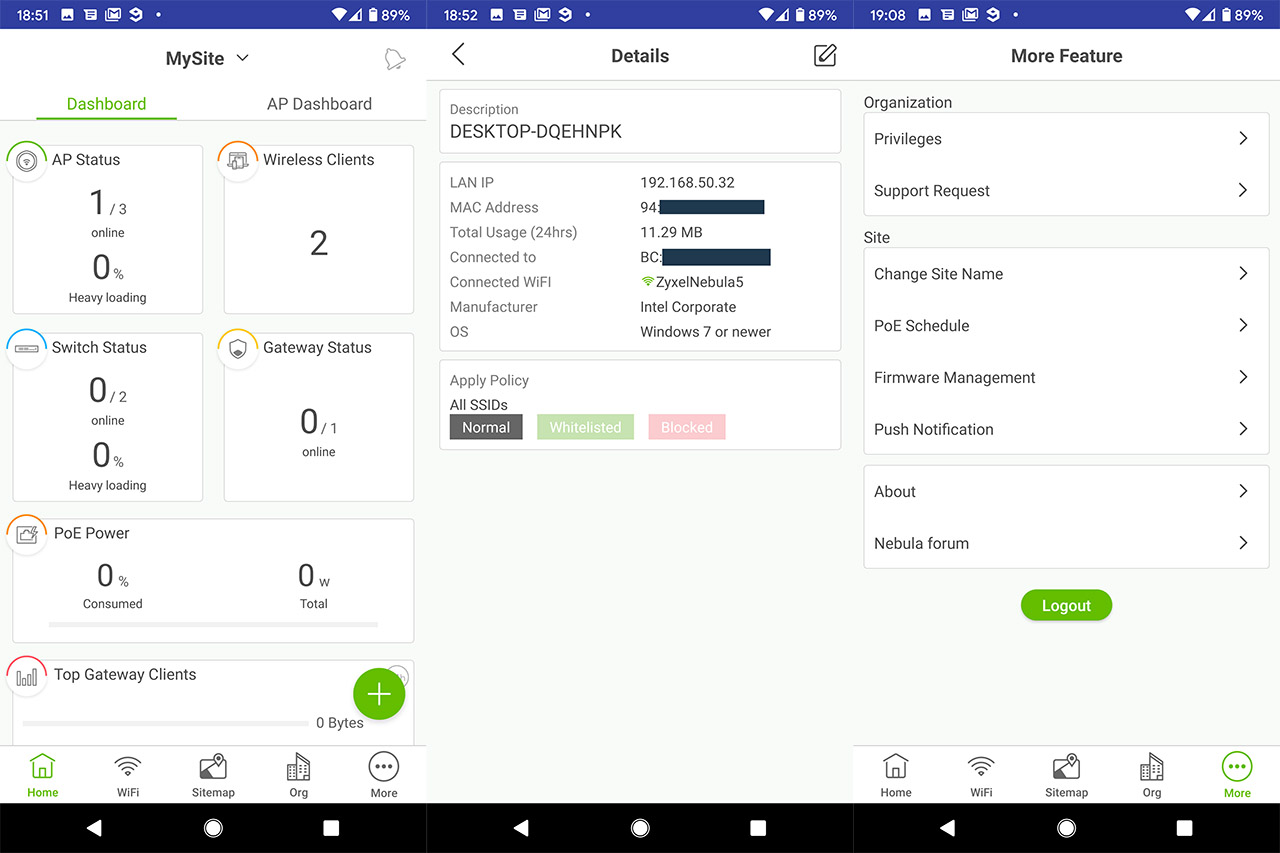
The Configure grouping of options includes the SSIDs where yous can set upward general SSID settings for all the APs on the current Site (every new adopted admission point will receive these settings); you tin can also configure the Radio settings (maximum output power, the channel width or the DCS setting), the Port setting (can be set for each private AP), the Authentication settings (includes the WLAN security, enabling the Convict Portal), the Assisted roaming, the U-APSD, the Walled garden, the Layer two isolation or the Intra-BSS traffic blocking), the SSID schedule or the possibility of personalizing the Captive Portal (which is very useful especially for hotels or airports).
2. TP-Link EAP660 Hard disk WiFi half dozen Admission Point
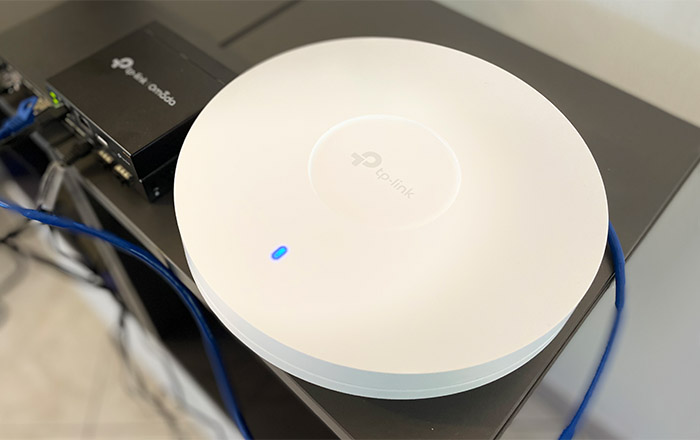
Read the total review
![]()
TP-Link has been one of the main providers of affordable consumer-friendly wireless access points and, always since the WiFi 6 standard was launched, pretty much all manufacturers of SMB-suitable hardware raced to chop-chop release networking devices that could take reward of the newer technologies. I am familiar with the EAP series (the EAP245) that was using an early version of Omada and information technology seems that in the meantime, TP-Link has made some serious advances and it now includes both gateways and switches (also the WiFi APs), and so what better time to showcase these advancements than with a new WiFi admission point, specifically the EAP660 Hard disk.
Similarly to nearly other ceiling wireless admission points, the TP-Link EAP660 Hard disk went with a simple design, the case having a round shape and the entire device is covered by a white matte stop. But, despite keeping everything as minimal as possible, the access signal is nonetheless very big and substantially thick, measuring ix.6 10 ix.half-dozen 10 2.5 inches, so it'southward going to be very much visible on the ceiling. As I accept seen with some Ubiquiti access point over the years (such as the UAP-Air-conditioning-PRO), the wireless admission points that are designed to sit down on the ceiling have a tendency to run fairly hot, but it seems that TP-Link has taken the necessary precautions against such beliefs. Indeed, the total-plastic case and the multiple openings will help the AP to remain only a bit warm in the middle of the case.
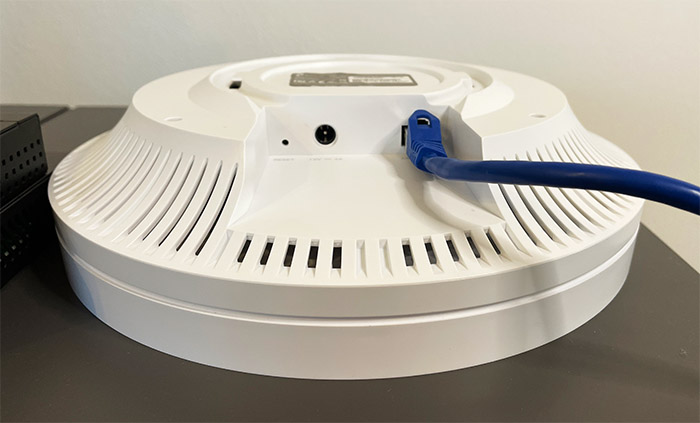
Simply like the EAP245, the TP-Link EAP660 Hd has a single adequately small-scale LED sitting at the top of the instance and it'south supposed to properly show the status of the access indicate. The LED indicator will quickly flash when the AP is upgrading the firmware, information technology will become solid when the device is working properly; the LED will be flashing red and bluish if the device has experienced an mistake. If you're looking for the ports surface area, you'll find it at the bottom, in a defended section. From the left, at that place's a recessed Reset button which, when pressed and held for v seconds, returns the AP to factory default settings; further to the right, there'due south the Power port and a unmarried two.5GbE port (to connect to the router – it's PoE compatible).
Yes, unfortunately, TP-Link decided to non add together an additional Ethernet port for wired clients (since the AP is going to end up on the ceiling or on the wall), so, only wireless clients volition be able to connect to the EAP660 HD – unless you use a multi-Gigabit PoE switch (such as the Zyxel XS1930 or the Zyxel MG-108). Within the case, the EAP660 HD is equipped with a quad-core 2GHz Qualcomm IPQ8072A SoC, backed by 512MB ESMT RAM (2x M15T4G16256A) and 128MB ESMT F59D1G81MB-AZM1P0H9N storage. Also, in that location'south the Qualcomm Atheros IPQ8072A 802.11b/g/northward/ax four×4:4 bit for the 2.4GHz radio and a Qualcomm Atheros IPQ8072A 802.11a/due north/ac/ax 4×4:4 for the 5GHz radio.
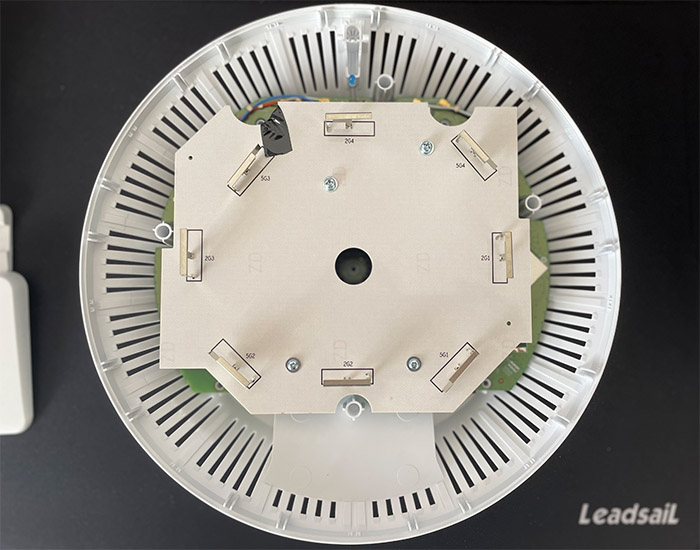
Now that we had a look at the hardware, let'due south see what kind of performance this access point can evangelize. To do so, I continued a computer to a multi-Gigabit switch, the Zyxel XS1930-12HP which was and so connected to the EAP660 Hd and and so a WiFi 6 client (AX200) was connected to the 5GHz network (80MHz). Upstream, I measured an average of 979Mbps at five feet and 562Mbps at thirty feet; from the server to the client, the WiFi 6 access betoken delivered 882 Mbps at 5 feet and 546 at 30 feet. Later, I connected the wireless client to the 2.4GHz network and, from the customer to the server, at 5 feet, I measured an boilerplate of 368Mbps and, at 30 feet, the speed went down to 179Mbps. From the server to the client, I measured and average of 337Mbps at 5 feet, while at 30 anxiety, the throughput decreased to 172Mbps.
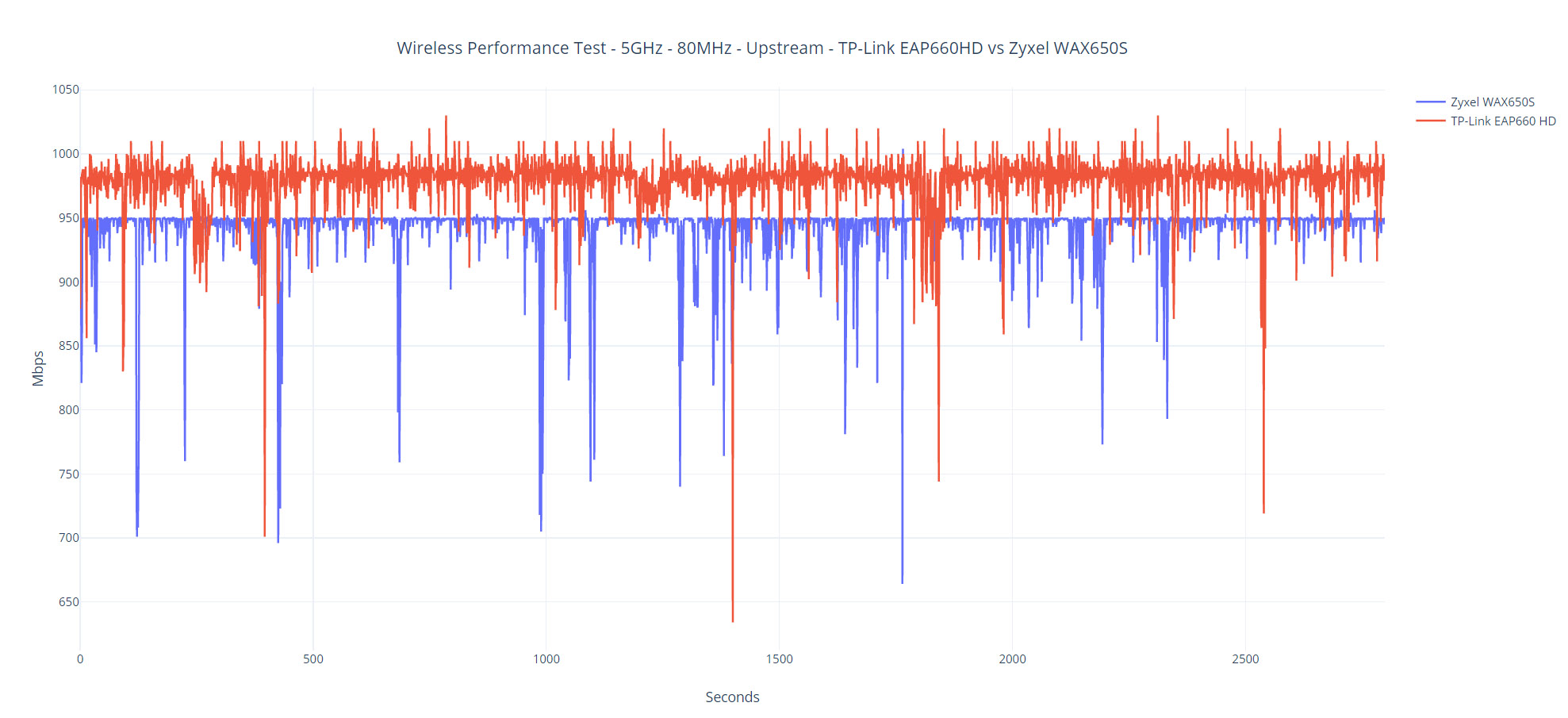
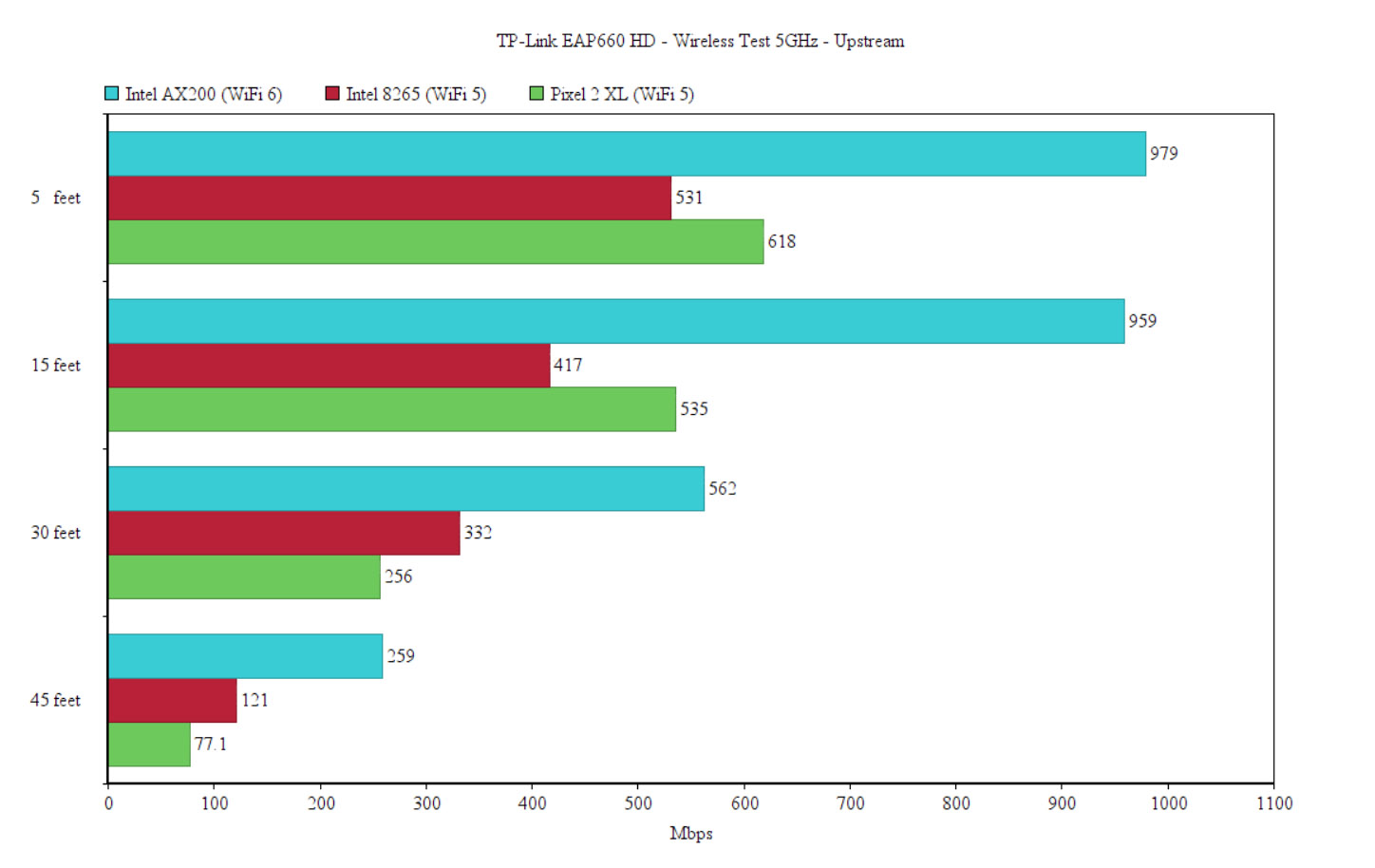
The TP-Link EAP660 HD can either be run as a standalone device (the usual option for habitation users) or as part of a larger environment by using the Omada controller. To do the onetime, yous demand to run an instance of the controller on your hardware (a PC, a Raspberry Pi or using a defended device, such as the OC300). The Chinese-based manufacturer has been pushing dorsum confronting Ubiquiti's dominance for years and, after some questionable decisions from the latter company, it does seem that TP-Link may be able to persuade some of the users that felt neglected. I am saying that because the Omada controller has the same feel equally the UniFi, as well as very similar interface and controls.
3. EnGenius ECW230 WiFi 6 Access Point
Read the full review
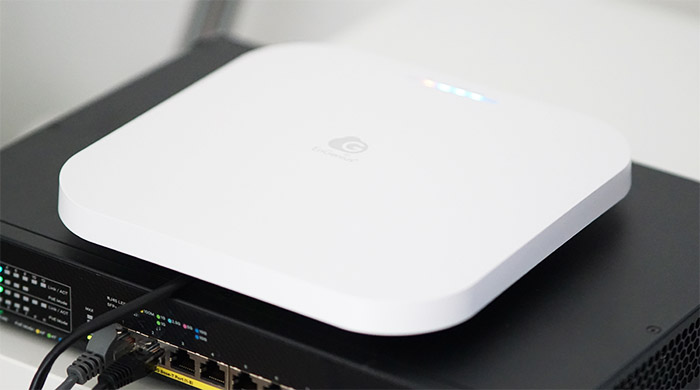
![]()
The EnGenius ECW230 was the first AX access point that institute its way into the best wireless AP listing and it was only a matter of time considering that the WiFi vi standard has been out for more than a twelvemonth. The ECW230 is a non WiFi six certified device (it's office of the draft stage), but it does come with most of the new technologies such every bit the OFDMA and TWT, as well as some improved ones from the previous standard (MU-MIMO, BeamForming). Just, something that seems to slowly become a standard with newer wireless access points is the apply of a multi-Gigabit port. And yes, the EnGenius ECW230 does have a 2.5GbE port to allow you to brand full utilize of its performance.
Despite needing more powerful components, the EnGenius ECW230 is incredibly compact (especially when compared to one of its competitors, the Zyxel WAX650S) and information technology'south one of the most elegant access points that I have tested, sporting a flat minimalist plastic case covered past a white matte finish. The bottom side is metallic, but the ECW230 volition most likely end up on the ceiling and it'due south going to look peachy. Of course, EnGenius has included everything that's necessary for mounting the device on the wall or ceiling, only since there are no silicone feet, you lot won't be able to proceed it on the desk.
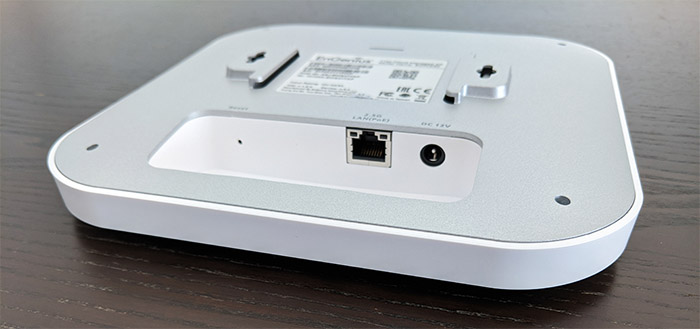
On the front of the wireless point, there's a fairly subtle bar of LEDs (which are quite bright, but can be turned off) and, from the left, there'south the Power LED, the LAN LED and the two LEDs for the WiFi networks (2.4GHz and 5GHz). Plow the access bespeak around and you'll be able to run across a carved-in area that contains a recessed Reset button, the 12VDC power port and only one Ethernet port. It makes sense to utilise only ane port for ceiling access points, only it's all the same annoying if yous desire to put information technology on the wall next to a printer (which may accept used a secondary port). The proficient news is that it's a ii.5GbE port that supports 802.3at PoE Ethernet switches or PoE adapters.
I too opened the case to cheque its components and I could identify the quad-core Qualcomm Atheros IPQ8072A chipset (clocked at 2.0GHz), 256MB of flash retentiveness and 512MB of DDR3 RAM. For the WiFi, there's the IPQ8072A scrap (QCN5054) for the 5GHz radio and the IPQ8072A chip (QCN5074) for the 2.4GHz radio.
In terms of wireless operation, the ECW230 did not bad, being one of the most powerful access points that I have tested. Using a WiFi 6 client (AX200) on the 2.4GHz radio ring, I measured an upstream speed of 239 Mbps at 5 feet, it decreased a bit to 203 Mbps at 15 anxiety and lastly, information technology managed 143 Mbps at 30 feet. Furthermore, I tested the admission point using the 5GHz radio band (80MHz – the maximum channel bandwidth bachelor) and the upstream throughput was 817Mbps at close range, 693Mbps at around 15 feet and a subtract to 330Mbps at thirty feet. The WAP561 allows you to access a very basic web-based configuration utility by inbound the IP address of the AP into a browser of your choice, but this is a Cloud-managed access point, then yous'll go far more than by adopting the device to the EnGenius Cloud platform.
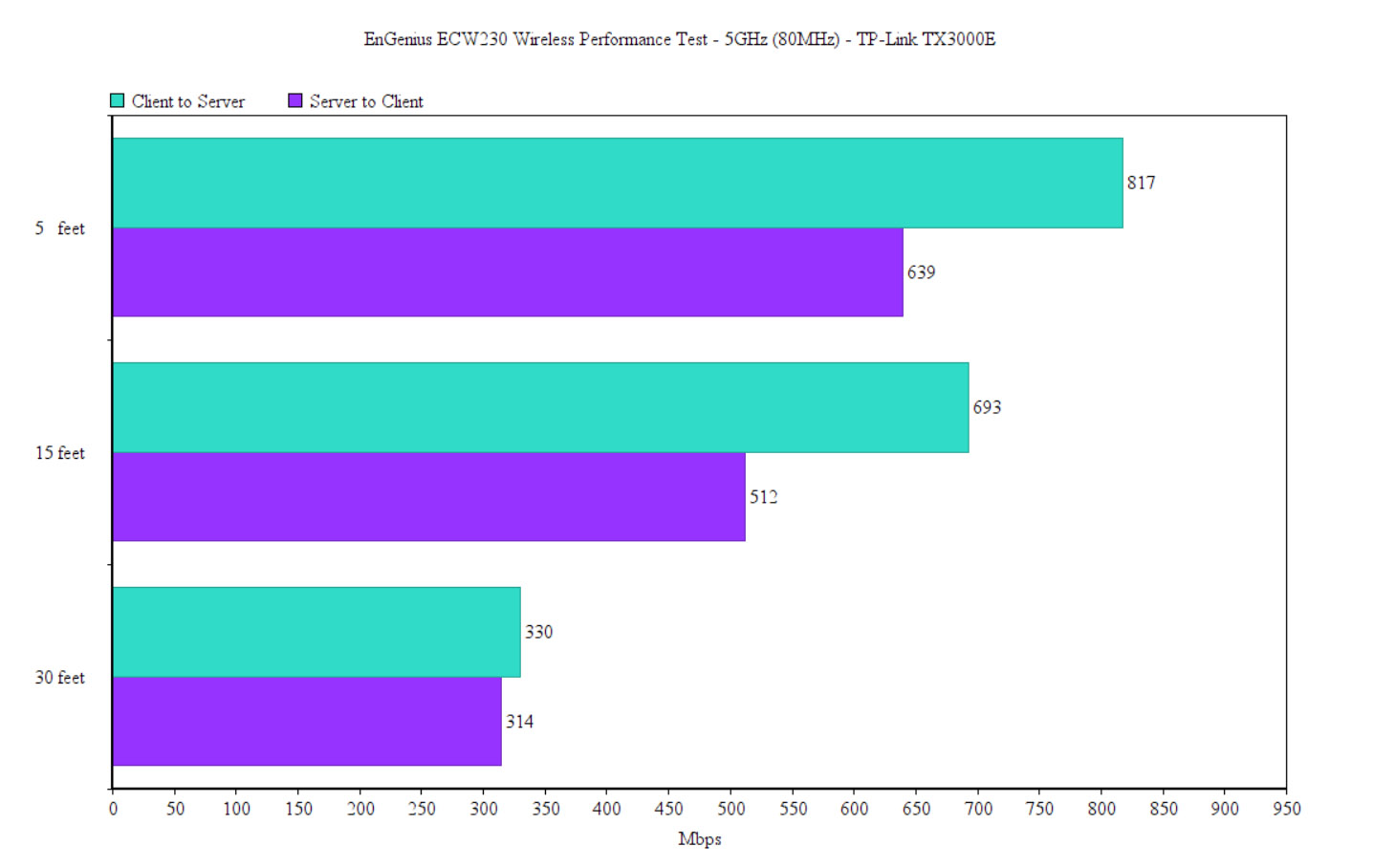
The point of all Cloud platforms is to allow an easy management for more than than a single access point, Ethernet switch or gateway, too as a quick configuration deployment to one device, a group of devices or all at the same fourth dimension. So, the ECW230 will work great along with other Engenius products and the Cloud platform does support all types of devices. Of course, GUI is feature-packed, and then I will mention a few: in that location's the Captive Portal with the Splash Page (likewise as various Authentication types, including past voucher or RADIUS), in-depth radio settings and more. There'south also a dedicated EnGenius Deject app for mobile devices.
iv. Ubiquiti UAP-nanoHD Wi-Fi Access Point
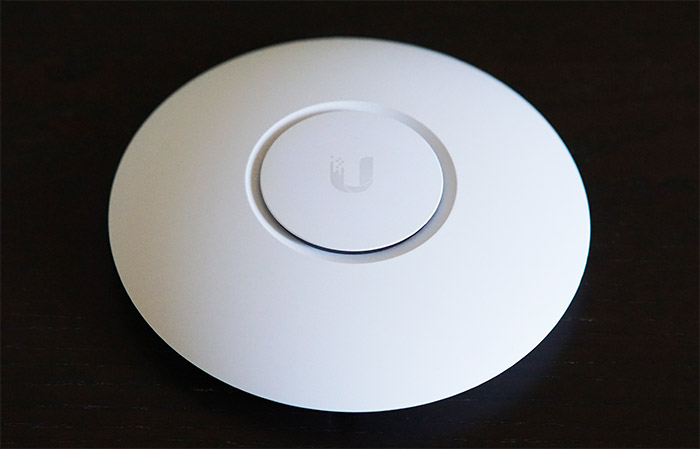
Read the total review
![]()
The Ubiquiti UAP-nanoHD is the successor to i of the best wireless access points (WiFi 5) developed for SMBs, the UAP-Air-conditioning-PRO and it's not just small-scale increments in performance, the new device is pretty much a complete overhaul of its predecessor, at present offering MU-MIMO, four spatial streams, it'south built on the Mediatek platform, instead of Qualcomm (as it did its predecessor) and the case itself, despite having the same blueprint, is much more than compact.
Indeed, the Ubiquiti NanoHD sports a smaller and more compact case (measures 6.30 x 6.30 x 1.29 inches), just the look is pretty much the same, then the case has that saucer shape, it'southward covered by a white matte finish and at the elevation, in that location is a narrow canal that circles around to let the LED to shine through. The LED is significantly brighter than on the UAP-Ac-PRO, only it has the same functions: white means that the admission signal is not nevertheless paired, solid bluish ways that the AP is added to the network and works properly and flashing blue means that the device is flashing blue slowly. The plastic case on the UAP-AC-PRO was completely sealed, allowing the user to mount information technology outdoors, simply, considering that most people used the wireless access point in the office or their homes, the UAP-nanoHD is indoors-simply (this way, Ubiquiti could push forrard its outdoors series more easily).
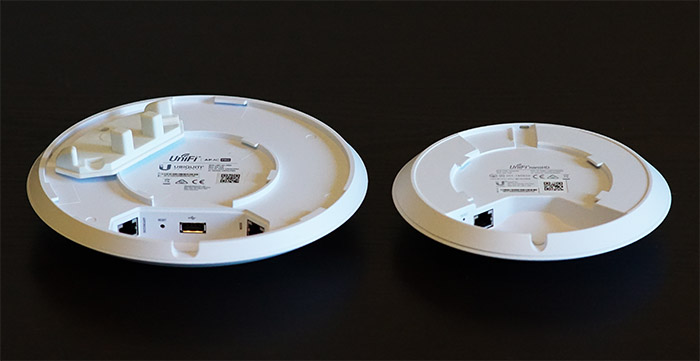
There are no ventilation cutting-outs anywhere on the instance of the NanoHD, but the silicone seal is missing, so h2o and grit tin can enter the enclosure. The good news is that the wireless access point does not get hot, while it'southward predecessor would always function at a higher than comfortable temperature. I design selection that I'1000 not actually addicted of is the removal of the secondary LAN port which ways that on the bottom of the NanoHD, yous simply get a Reset button and a Gigabit PoE+ Ethernet port (802.3af). Considering that Ubiquiti didn't requite any option to power up the device using a power cable, yous either take to use a PoE switch (you can read here a listing of the all-time Ethernet switches on the market) or a PoE adapter – bear in mind that the manufacturer has added a PoE adapter inside the parcel.
All Ubiquiti wireless access points make use of the UniFi Controller software in order to undergo any configuration changes to the device and to the network. The UniFi has been long regarded as the all-time controller for SMB equipment and it has created a pattern which has been followed by many other manufacturers. As a quick overview (you can read more by checking out the defended review), the interface has a left vertical menu divided into two sections: the offset includes the Dashboard (a graphical representation of the download and upload latency / throughput, the number of devices on the ii.4 and 5Ghz channels, the number of devices, clients and the Deep Packet Inspection), Map (you can view or create a graphical topology of your network), Devices (displays a list of all the UniFi devices discovered past the Controller), Clients (displays a list of the network clients and allows you lot to configure them), Statistics (number of Clients, the Top Access points, a Quick Look over the most active AP and client, every bit well as Recent Activities) and Insights.
The 2nd department includes the Events, Alerts, Settings and Conversation with Us. I have as well tested the Ubiquiti UAP-nanoHD using a couple of computers, 1 as the server and the other as the client (I have really used two different clients, i equipped with a Tp-Link TX3000E and the other with an Intel 8265). The results were really good, better than with the UAP-Air-conditioning-PRO (it'southward worth mentioning the support for 160MHz channel bandwidth). As you tin see, from the client to the server, I saw an average of 665 Mbps at 5 anxiety on the 5GHz network using the 160MHz channel bandwidth and 647Mbps on the 80MHz way; using the Intel 8265 customer, the throughput at 5 feet was considerably lower at 512 Mbps.
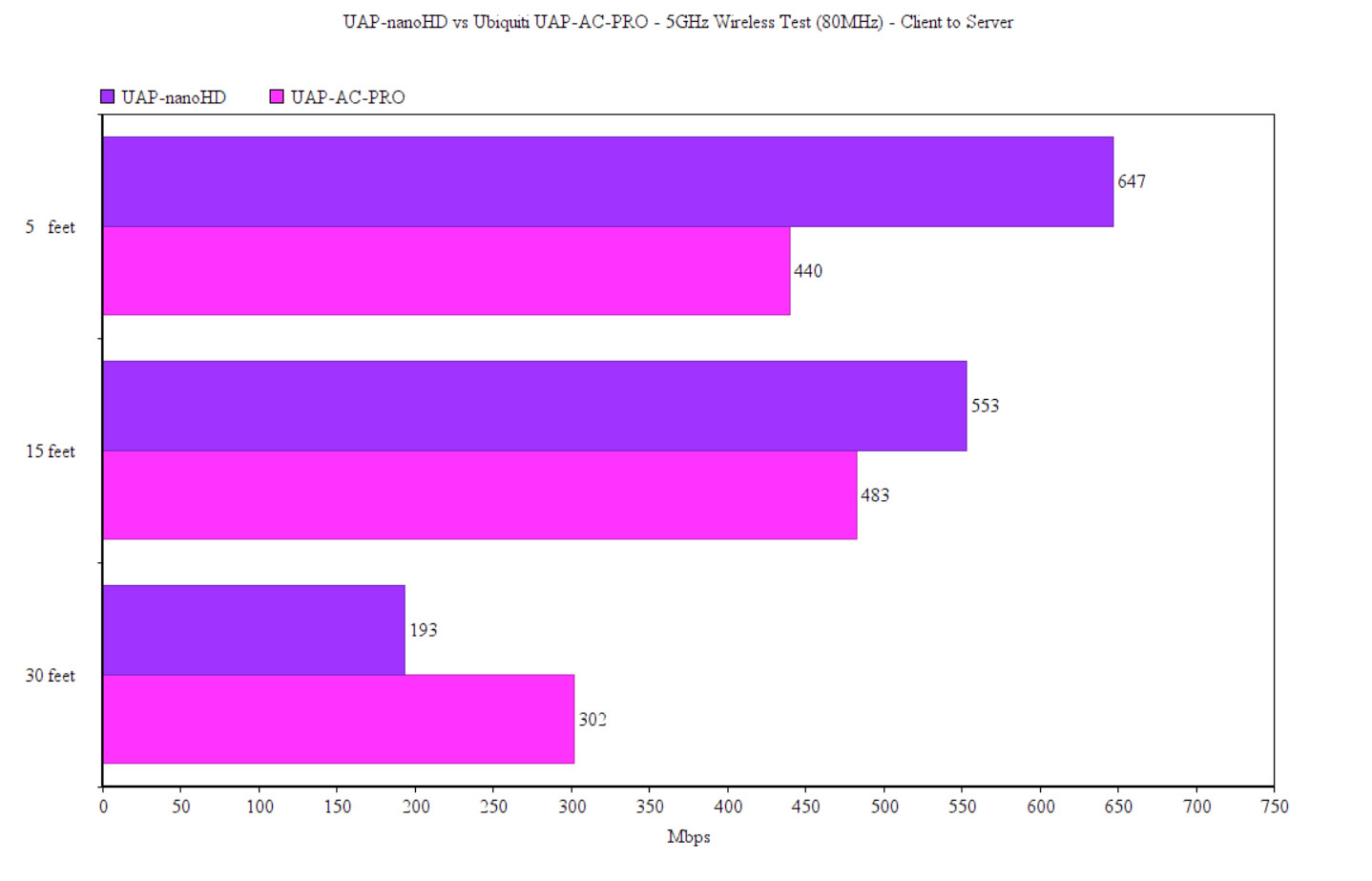
At 30 feet, I saw an average speed of 242 Mbps using the client equipped with the TP-Link TX3000E (on 5GHz, at 160MHz) and an average of 193 Mbps using the 80MHz channel bandwidth. Using the Intel 8265 adapter, the throughput was very similar, scoring an boilerplate of 228 Mbps.
5. EnGenius EnTurbo EAP1250 Wireless Admission Bespeak Review
Read the full review
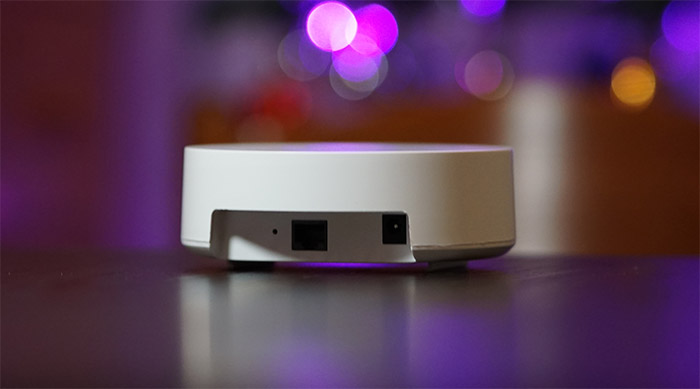
![]()
The shift towards Cloud-based management has been happening for a while now and, equally can be seen with nigh of the wireless access points that I have covered and so far, there's either a hybrid implementation (using both local and Cloud controllers) or purely Cloud-based direction. Long gone are the days when Ubiquiti was pretty much the only manufacturer to offer an accessible alternative to the enterprise-level products and now EnGenius has released a serial of networking devices (WiFi 5 and WiFi 6) to assist the SMB to reliably manage a large number of clients on multiple sites. The device that I'grand going to focus is not a Cloud wireless access point, but information technology can nevertheless be added to the ezMaster platform using the SkyKey, which is a concrete On-Premises network controller with Deject Management. This way, the EnGenius EnTurbo EAP1250 becomes a hybrid-blazon wireless admission point which has a local management interface and should be able to as well receive a global configuration using the Cloud.
In terms of pattern, the EnGenius EnTurbo EAP1250 is just as uncomplicated and minimalist as most other APs on the marketplace, just, what differentiates it from its competitors is the size: the device is incredibly compact, even for an AC1300-class admission point and overall it's actually merely a small plastic cylinder – information technology measures ane.47 ten 5.2 inches (elevation and diameter). Following the minimalist tendency of the WiFi mesh systems, the EnGenius EAP1250 is covered by a white matte terminate and, with the exception of the tiptop-printed logo, at that place really isn't much else going on, well, with the exception of the small LED that hides on the side of the device and it has the function to inconspicuously show the status of the AP and the network. Moving on the the bottom of the EnGenius EAP1250, we encounter an info label and side by side to information technology, EnGenius has defended an area for the ports: from the left, there's a Ability port, followed by an Ethernet port and a pocket-sized recessed Reset button (press and hold it for 10 seconds to return the device to factory default settings).
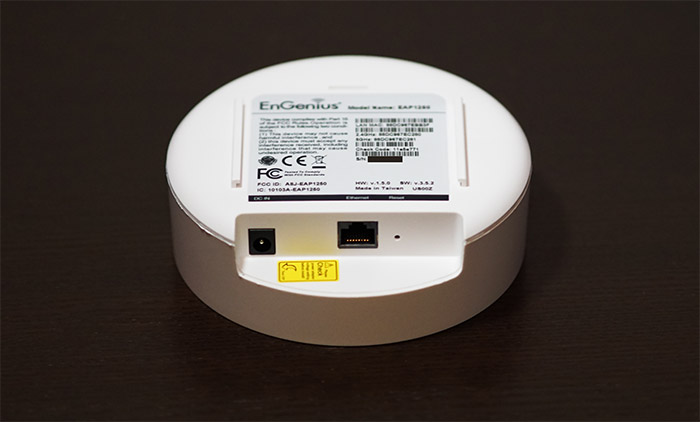
Every bit I said many times, information technology'due south appropriate to take at least 2 Ethernet ports since in that location is a loftier chance that you may want to connect a wired customer, and then the single Gigabit port is far from ideal. Yet, it does support the 802.3af/at PoE standard, so, if you don't want to utilize a DC cord, then yous can power on the EAP1250 via a PoE switch. Looking around the case, I noticed that at that place are no cut-outs to ensure a decent airflow, which means that the temperature inside the device can up by quite a bit.
I have decided to configure the EnGenius EnTurbo EAP1250 using the SkyKeyI so, after inserting the IP address of the AP into the URL, I got access to the ezMaster Login window which took me to the local user interface. Of course, it's not entirely defended to the Access Points, since there'southward too a section dedicated to the Switches, but the AP expanse does evidence some useful stats at the Dwelling house folio. You can as well create a Mesh network with multiple compatible APs, view whatsoever Agile Clients, set the Captive Portal and more (read more than on the total review of the EnGenius EAP1250). As I said in the introduction, you can also add together the EAP1250 as part of the Deject management platform, although it'southward going to feel more than limiting than when using a Cloud AP.
Now allow'southward have a look at the wireless performance of the EnGenius EAP1250. Since it has a single Ethernet port, I had to rely on a PoE switch (I chose the TRENDnet TPE-LG80 unmanaged PoE switch) and, after creating two SSIDs, one for the 2.4GHz and the other for the 5GHz connection, I used two computers to exam the throughput (one wired and the other wireless – equipped with an ASUS PCE-AC88 WiFi adapter). That beingness said, commencement, I connected the client to the 2.4GHz WiFi network and, from the customer to the server, I measured an average of 270 Mbps at 5 anxiety and an average of 121 Mbps at 30 feet; next, from the server to the customer, I measured around 164 Mbps at 5 feet and an average of 108 Mbps at 30 anxiety.
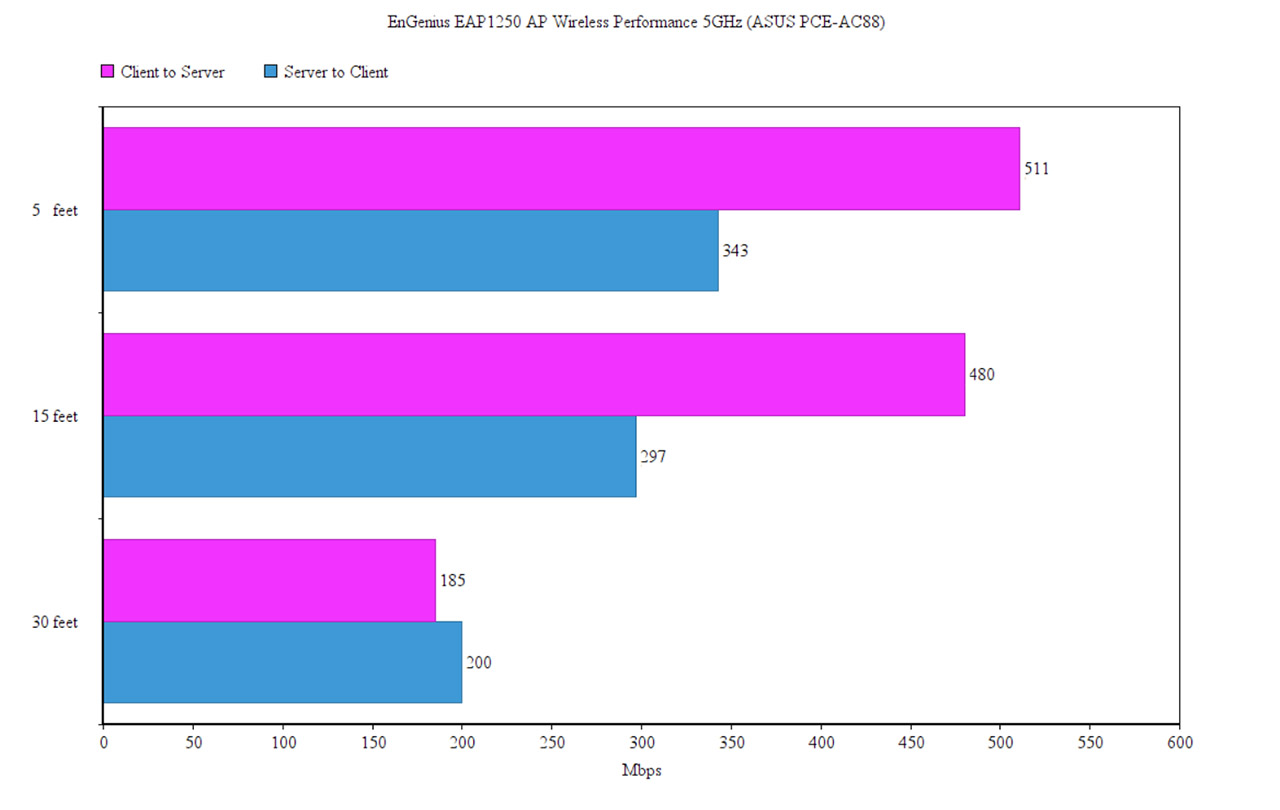
Afterward, I connected the client to the 5GHz WiFi network and, from the client to the server, I measured an average of 511 Mbps at 5 feet, while at 30 anxiety, the speed decreased to 185 Mbps. From the server to the client, at 5 anxiety, I got around 343 Mbps and, at 30 feet, I measured an boilerplate of 200 Mbps.
6. Linksys LAPAC1750C WAP
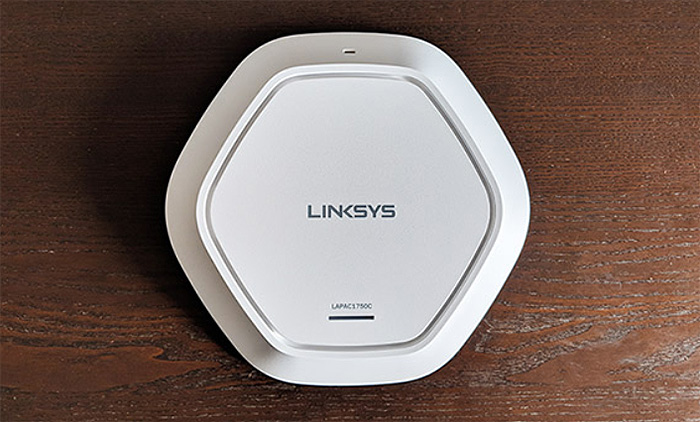
Read the total review
![]()
The Linksys LAPAC1750C is part of the new wireless access points that back up the Deject controller out-of-the-box, merely besides this new software, the device is still identical (in terms of hardware) to the v year sometime LAPAC1750. Despite that, the LAPAC1750C is nonetheless suitable for today's exigence (they rarely change that much in this market), so, it notwithstanding respects the design trend of compact circular or hexagonal-shaped devices that can be easily positioned anywhere (even on the ceiling). The case of the LAPAC1750C is basically identical to any other from the LAPAC serial, and so we're dealing with a hexagonal shape, only non with sharp angles, adopting soft, rounded corners instead (everything covered by a white matte finish). On the top you can find the Linksys logo, along with the model and a modest bar for the LED lights just underneath. There's also a narrow canal surrounding the acme of the device and from this place, the case flows from the narrower meridian side towards a larger footprint.
When compared to the likes of Ubiquiti UAP-AC-PRO or even the Zyxel NWA1123-Ac Hard disk, the LAPAC1750C is amongst the largest I have tested and so far, measuring 9.57 x 9.33 x i.72 inches but it does weigh a bit less than the Zyxel AP (1.12 lbs). The LAPAC1750C is meant to exist positioned on the wall or on the ceiling, equally it comes with the whole kit for mounting (including a drill layout template), but, if you decide to keep it horizontally on a desk, there are iv small-scale round silicone anxiety that should ensure a reasonable level of stability.
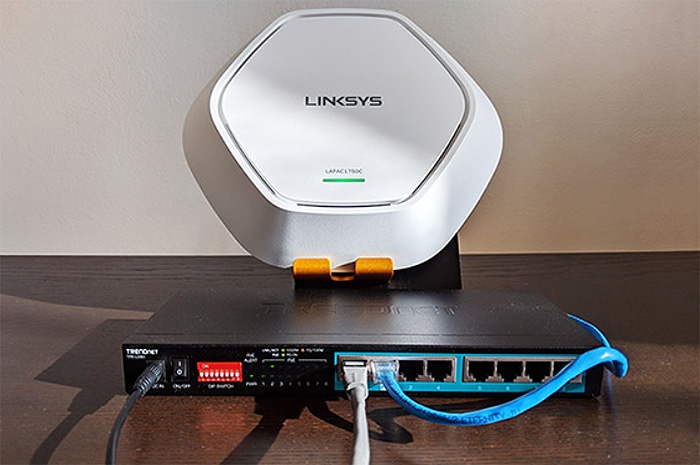
Turn the wireless access point upside downward and you'll be greeted by lots of punctured holes which ensure a proper airflow forth with a carved-in surface area where y'all can find the ports and connections: there's a Power port (only use the adapter that came with your AP), a single Ethernet Gigabit port (PoE+) and a red Reset button.
The LED calorie-free from the summit of the case volition glow a solid green if the system is normal and no wireless client is continued (it volition glimmer when the device is booting). The LED indicator will also blink a bluish light if there is a firmware upgrade in progress and will be solid blueish if at least one wireless client is continued; lastly, the LED indicator volition be solid ruby-red if the booting process has failed or the firmware update was unsuccessful.
Annotation: While some other access points come with a PoE injector, Linksys has decided to not include ane in the package.
More often than not, the admission points focus on different things than routers (similar multiple SSIDs with multiple VLANs), and so information technology won't come every bit a surprise that the LAPAC1750C may not outshine a AC1750 router in terms of wireless performance, even though the access point itself is branded equally AC1750. Despite that, the LAPAC1750C Pro is a worthy performer and the examination results are actually skilful.
To test the wireless performance, I took two computers, one as a client (ASUS PCE-AC88), the other as a server and, get-go, I connected them to the 2.4Ghz radio band. This way, from the customer to the server, the LAPAC1750C reached an average of 133 Mbps at shut range (v feet) and it slowly decreased to 120 Mbps at thirty feet. From the server to the customer, I measured and boilerplate throughput of 104.9 Mbps (at 5 feet) and after, I got 94.2 Mbps at 30 feet.
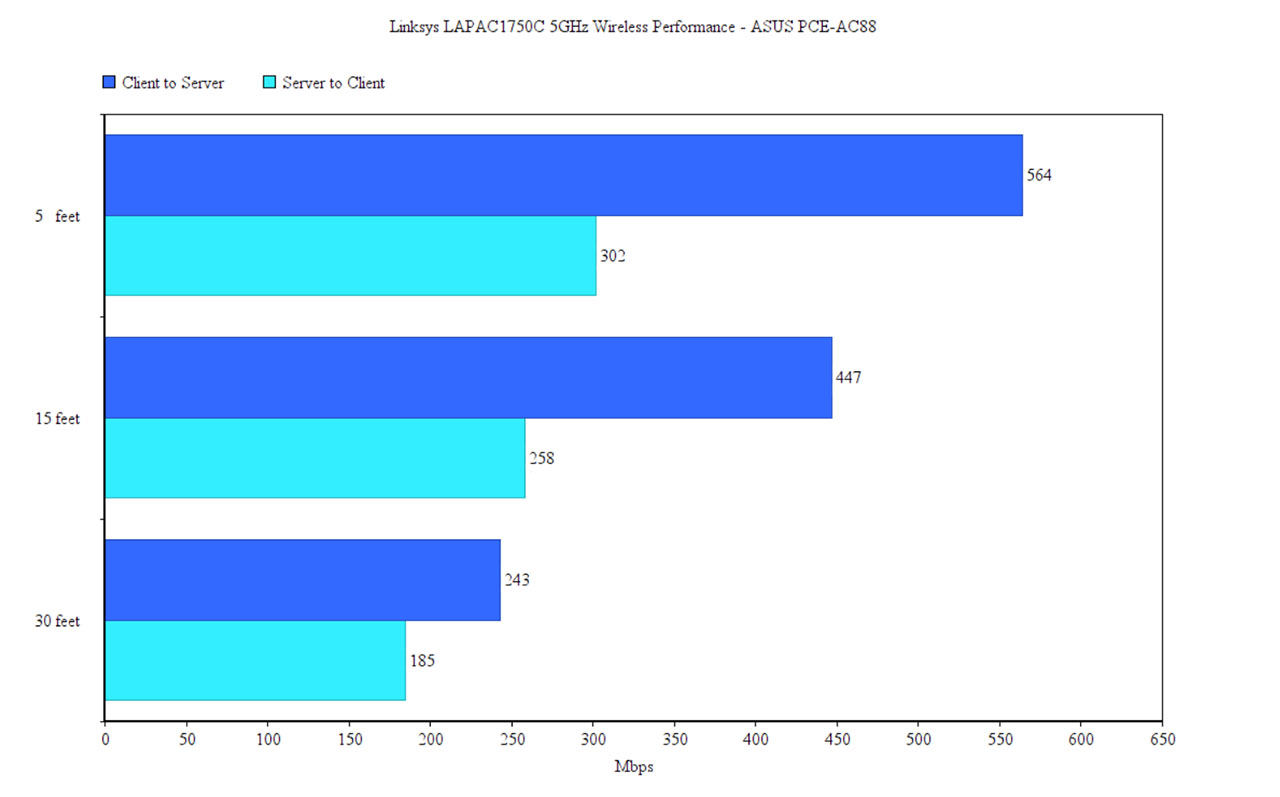
After I connected the computers to the 5GHz network, things were a lot amend. At close range, from the client to the server, I measured an average speed of 564 Mbps and then, the speed decreased to 243 at 30 feet. From the server to the client, the access point managed to evangelize an average of 302 Mbps and around 185 Mbps at thirty anxiety.
In terms of wireless functioning enhancing features, the LAPAC1750C is quite bare-bones, lacking the MU-MIMO engineering which has the ability to serve multiple clients at the same fourth dimension, instead of letting them compete for the bandwidth, but it does come up with support for the 802.11k Roaming technology which negates the demand for re-hallmark every time the client roams to a new node (Fast Basic Service Set Transition).
The reason of existence of the LAPAC1750C is the centralized direction arrangement which allows the creation of access points clusters that tin can then be managed by a single controller. The Linksys Cloud Controller, equally its proper name suggests, is Cloud-focused, but the manufacturer has made information technology costless for 5 years – yous can still utilize the LAPAC1750C in the offline mode, where you lot merely enter the IP address of the device and exercise the necessary configurations. To admission the Deject controller, you lot'll need a Linksys account and to simply pair the AP to the software (the process is very simple and painless). Some of the main features that the controller offers are VLAN tagging, Bandwidth Limit, Splash Page (offers a very comprehensive way of creating a splash page: you can alter the styles, the login instructions, the terms of use policy, the authentication type (countersign-but at this time) and more), Customer Isolation, 802.11k and some Tools (which includes a Ping Tool and the Rogue Access Point Detection).
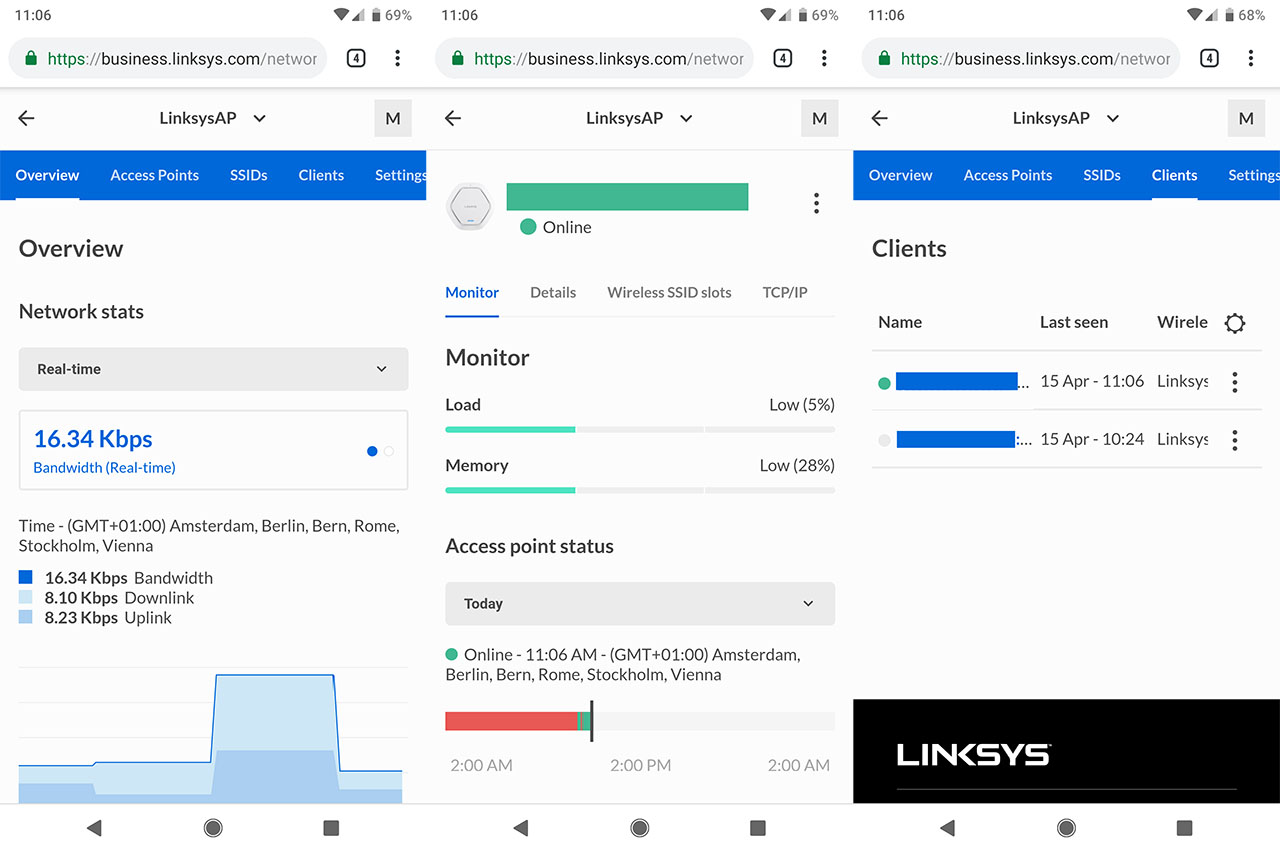
The local web-based utility will but piece of work for one admission point at a time (while the controller allows for a mass deployment of APs with fast an easy monitoring and configuration procedure), but it does have some boosted features, such as WDS, Workgroup Span, SSID Isolation and RADIUS back up for the Splash Page. I do expect that Linksys volition make the Controller a more complete solution and I do hope that more than types of devices are underway to be added under a single software.
What should you take into account before choosing a wireless admission betoken?
Wireless Performance and Range
Obviously, the most of import aspects of a wireless access point is the downlink and uplink throughput and how far tin the signal reach. For example, if you use the 2.4GHz radio band, chances are that the signal volition go for a long way, but the speed won't exist strong, while if using the 5GHz radio band, the speed will exist profoundly improved, but don't look huge distances to exist covered.
Besides, you need to have into business relationship the interferences, the number of clients, the surface that needs to be covered and if you need more than a single access bespeak.
The Web Interface/App
This is also a very of import aspect, because you demand to be able to configure and, if needed control a large network. Ideally, a skillful interface is easy to navigate, the settings are clear and intuitive and the AP should take as many features equally possible for you lot to fiddle with.
Likewise, you need to check out whether y'all tin can admission the interface through an Internet browser or y'all need to employ an app (or both) and if the software allows you lot to remotely control the network.
Price
Lastly, we have the price to worry near, because you need to know where you stand based on your budget. Usually, the consumer-blazon access points are cheaper, but they lack a lot of the features of an enterprise-level AP.
You should also go along in mind that some popular products can be overpriced (because of their popularity) and that in that location could be some rare gems from notwithstanding-unknown or rising networking manufacturers that could deliver the same feel at a lower toll.
What features should yous look for in wireless access points?
PoE
The Ability over Cyberspace is quite a simple concept (simply extremely important) that allows your access point to receive power through a twisted pair Ethernet cabling (so you become both electrical power and data, using a single cablevision).
Why is information technology useful? Many organizations similar to place the wireless admission points on the ceiling in club to assist the wireless clients achieve the all-time possible range, but they take to rely on extension cords (which have an ugly appearance and require a qualified electrician to install them).
That's why information technology's better to apply the PoE system, as you can install it yourself and it protects you lot devices from underpowering or overload. Some of the admission points on the market have a PoE injector included in the package, while other practice not (you volition have to buy it separately), so be certain to check it out before purchasing, if this is a mandatory characteristic for your network.
Concurrent dual band
You may be surprised that some access points phone call themselves dual band, but, despite expectancies, information technology allows you lot to cull only one band at a time. A expert example is the Linksys WAP300N, which has both the two.4GHz and the 5GHz radio bands, but y'all can only use one or the other.
Load-Balancing
I've touched the bailiwick of load-balancing when I talked about the more popular dual-band routers on the market place and the importance of this feature was clear for any business possessor that values a stable network. Is this office also relevant for wireless admission points? Absolutely yeah.
Commencement of all you lot need to understand that the load-balancing feature was created to be used with more than one access point. This is because its part is to diminish the network congestion by spreading the sessions amidst the existing APs in such a way that they share the client load.
So, if you lot have a big number of clients in a smaller space, instead of overloading a unmarried access indicate, the load balancing spreads all the connected clients over all the APs, therefore in that location will be less interruptions and more bandwidth bachelor.
The Man in the Eye (Defense force against rogue access points)
A rogue access point is an unauthorized WAP installed (ordinarily with malicious intent) on a secure network. Therefore, the network becomes vulnerable to unlike types of attacks and can be accessed either from inside the facility or remotely (the more common occurrence).
That is why it is very of import that the access point to take a reliable wireless intrusion detection arrangement which audits all the APs on the network on a regular basis to run into if they are on the managed list and if they're continued to the secured network or not.
Beamforming
The Beamforming technology allows your access indicate to focus the signal towards each client and to concentrate the information manual towards a specific target, instead of broadcasting it all over the room, therefore minimizing the data waste.
If a few years ago this technology was optional and exotic, present, almost all devices accept this characteristic implemented (still, brand certain to check before the purchase). Also, you need to know that every major manufacturer will have its own way of using this engineering science and it may have a different name and different performance, simply the functionality should remain basically the aforementioned.
Mesh Networking Support
The mesh network support is 1 of the virtually important features to look for when ownership an access point considering information technology allows yous to add other APs and create a network where all the nodes (APs) cooperate with each other when distributing the data.
An interesting feature of a mesh network is that the data is propagated along a path and it travels from i node to the other until it reaches its destination. This way, it has to detect the best road and, if needed to reconfigure itself in instance of broken paths (using self-healing algorithms).
It too allows for an interrupted experience when travelling into a large building, by automatically switching from AP to AP so you lot won't notice whatever disconnects.
802.11n or 802.11ac?
Future-wise, an investment into Access points that feature the AC standard should exist the better choice. If you want to create a network using APs compatible with the 802.11n standard, you don't have to worry, because, if needed you lot can supersede them in fourth dimension and the N-admission points and AC-access points are compatible with each other and piece of work great with clients of both breeds.
Now, if yous are curious about the technical differences betwixt the two standards, allow'due south simply say that the 802.11ac standard delivers upwardly to 3 times faster speeds and, while a Northward-access bespeak can handle no more than xxx-35 clients in society to maintain a reasonable bandwidth for all, an AC-access signal has no such limitations.
Lastly, the price could make a departure, because, as expected, the AC applied science is way more than expensive than the N technology.

Marker is a graduate in Information science, having gathered valuable feel over the years working in Information technology as a programmer. Marker is also the main tech writer for MBReviews.com, covering not only his passion, the networking devices, simply also other cool electronic gadgets that you may find useful for your every 24-hour interval life.
Source: https://www.mbreviews.com/best-wireless-access-points/
Posted by: olmoinlyrib.blogspot.com

0 Response to "Will Ubiquiti Update The Ac Pro To Support 802.11 Ax"
Post a Comment